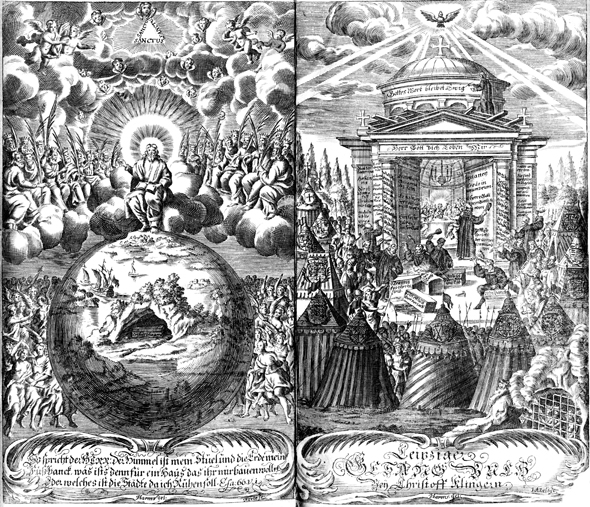Historiated Title Page
Author: Vopelius, Gottfried, 1645-171
Image Title: Historiated Title Page
Scripture Reference:
- Revelation (further images / scripture text)
- Ezekiel 36 (further images / scripture text)
- Ezekiel 37 (further images / scripture text)
- Ezekiel 38 (further images / scripture text)
- Ezekiel 39 (further images / scripture text)
- Ezekiel 40 (further images / scripture text)
- Ezekiel 41 (further images / scripture text)
- Ezekiel 42 (further images / scripture text)
- Ezekiel 43 (further images / scripture text)
- Ezekiel 44 (further images / scripture text)
- Ezekiel 45 (further images / scripture text)
- Ezekiel 46 (further images / scripture text)
- Ezekiel 47 (further images / scripture text)
- Ezekiel 48 (further images / scripture text)
- Isaiah 66 (further images / scripture text)
Description: This title page is an illustrative rendering of the Final Judgment as prescribed in the Books of Revelation, Isaiah, and Ezekiel. On the left page, God sits in heaven on a throne of clouds with his feet resting on a sphere representative of the “new earth,” which serves as his “footstool” (Isaiah 66). The image inside the sphere features the new earth and the river of the water of life which flows around a cave with a casket inside. God holds an open book on his lap, presumably the “book of life” used to judge the dead in Revelation 20:12. Above God is a nimbus and rays shining into the clouds interspersed with cherubs. In the top center of the clouds SANCTUS (Holy Spirit) is written three times to form the triangular shield of the trinity which emits rays from each side. Flanking God are the twenty four elders on twenty four thrones, each bearing a palm branch, a conflation of the elders with the great multitude of martyrs in white robes directly below (Revelation 7:9-17). At the bottom of the frame, Isaiah 66:1 is written in old German: SO SPRICHT DER HERR: DER HIMMEL IST MEIN STUHL UND DIE ERDE MEINE FUSSBANK; WAS IST'S DENN FÜR EIN HAUS, DASS IHR MIR BAUEN WOLLT, ODER WELCHES IST DIE STÄTTE, DA ICH RUHEN SOLL? The text translates “This is what the LORD says: Heaven is my throne, and the earth is my footstool. Where is the house you will build for me? Where will my resting place be?” The right leaf depicts the “earthly city,” Jerusalem, also called the “camp of the saints,” or the “camp of God’s people” (Revelation 20:9). At the close of the millennial period during the eschaton, military tents decorated with shields surround a temple-like structure. Christian soldiers bearing spears prepare for the final battle against Gog and Magog in Revelation 20:9, and other priestly figures carve and chisel cuts of stone in and around the temple, engraving honorific phrases like DOMINE REX (Lord the King) and ADORA MUSTE (we adore you) on the walls. The temple structure is surmounted with three crosses and a haloed dove, and the words HERR GOTT DICH LOBEN WIR (Lord God praise You) from Luther's German TE DEUM AMBROSIAN (A Song of the Church) are written across the entrance. Inside the building a lively banquet under a large chandelier is underway, reminiscent of the “heavenly feast.” Behind the military camp covered in billows of smoke is a barred cave imprisoning demons, suggestive of the pit of the abyss in Revelation 9:1 to which the fifth angel is given a key. Below the image is the title of the work, LEIPZIGER GESANGBUCH, which translates to “Leipzig Hymnbook.” The signature of the artist appears on the bottom right corners of each page.
Click here for additional images available from this book.
Request a high-resolution file (fees apply)
Rights Statement: The online edition of this work in the public domain, i.e., not protected by copyright, has been produced by Pitts Theology Library, Emory University.
Rights Status: No Copyright - United States
Pitts Theology Library provides copyright information as a courtesy and makes no representation about copyright or other legal status of materials in the Digital Image Archive.

